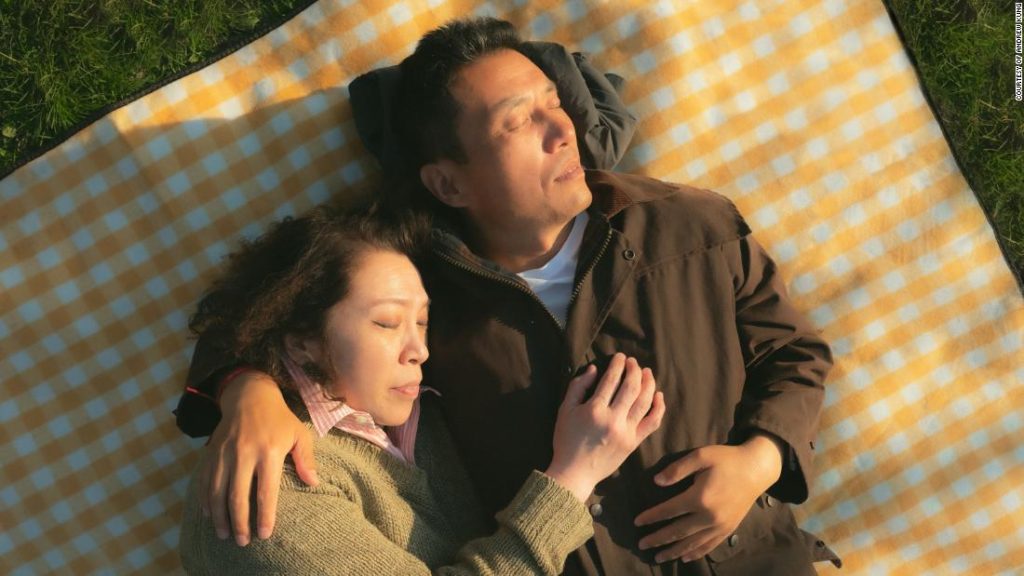But, on one of his first trips to the East Coast, Kung was crossing the street when a sanitation worker yelled at him, “Get out of the way, chink!”
“That was really the first time that I was like, ‘Wow,'” Kung recalled, “Even in a city like New York, I feel like the ‘other.’ I almost feel hyper-targeted, when I felt so invisible at the same time.”

Kung recreates his vision of the “all-American” family in this beach portrait, captured in Queens, New York, at dusk. Credit: Courtesy of Andrew Kung
“It’s another reminder that we are perpetual foreigners,” said Kung, who moved to Brooklyn in 2016. “We’re told to go back to our countries, when this is our home country.”
This idea has directly inspired Kung’s latest project, “Perpetual Foreigner,” a collection of over a dozen photographs of Asians occupying “everyday American spaces,” like parks or beaches, that Kung said usually elicit images of White families and individuals.
“I wanted to put Asian faces and Asian bodies in those spaces,” said Kung, who writes on his website that his work aims to “normalize Asian American beauty, belonging, and individuality.”
“These are the spaces that we inhabit,” he said. “And we deserve to be just as American as anyone else.”
Challenging stereotypes
Kung came up with the idea a few months into the pandemic following a conversation with his girlfriend, Kathleen Namgung, a Korean American who became a naturalized US citizen in 2016. Namgung, who has now lived in the country for almost 20 years, recalled an incident in school where a classmate was reprimanded for writing “let’s all bomb Korea” on a table.
“When I look back now, I can only imagine how frazzled and heartbroken my parents must have been,” she said in a video interview from New York. “They were super excited to bring their kids to a new country, only for their kids to get ostracized at school like that.”
A black-and-white image from Kung’s new series features Namgung reclined in a bedroom with an American flag draped against the wall. Looking directly into the camera lens, she appears at ease.
“I was really inspired to put her into this all-American environment,” Kung said, “where you can just look at the photo and be like, ‘OK, she belongs there.’ She’s not a perpetual foreigner. She has just as much right as anyone to proudly hang this large American flag in her bedroom.”

Kung photographed his girlfriend Kathleen Namgung against an American flag. Credit: Courtesy of Andrew Kung
In another photograph, reminiscent of a scene from Oscar-winning movie “Moonlight,” a father carries his two young children at the beach in blue twilight. Kung said he wanted to highlight the intimacy in Asian families and counter the stereotype of Asian parents being emotionally distant or unaffectionate.
Kung included an image of his own parents, Eric Kung and Ping Huang, in the series as well. The smiling pair are depicted holding each other in a park before sunset on a spring day, with a burst of pink magnolia blossoms visible in the background.
The photographer said he wanted to include his parents in the project because he is inspired by their love story. His father served in the military in North Carolina and his mother had immigrated to South Carolina from China to study music. They met at a restaurant where Kung’s mother worked and married in 1989.
“I wanted to show people a mature love, from my lens as their child,” Kung said. “When my dad was in the army, my mom immigrated here to study at a US school, they settled down in the Bay Area and had me. How much more American can you get?”
Finding the nuance
As a balm to the anger and discrimination, the photographer hopes to highlight the “beauty of Asian-Americans and what Asian joy looks like.”

Kung’s parents Eric Kung and Ping Huang seen relaxing on a picnic blanket in the late afternoon sun. Credit: Courtesy of Andrew Kung
These ideas are evident in Kung’s previous projects, too. In 2018, he used photography to challenge the Black and White racial binary in the American South by spotlighting Chinese American communities living in the Mississippi Delta.
“For so long, Asian Americans have been invisible,” Kung said. “They’ve been seen as the model minority who put their heads down and just work hard. But there’s such a nuance in what it means to be Asian American in the US.”
You may also like
-
Afghanistan: Civilian casualties hit record high amid US withdrawal, UN says
-
How Taiwan is trying to defend against a cyber ‘World War III’
-
Pandemic travel news this week: Quarantine escapes and airplane disguises
-
Why would anyone trust Brexit Britain again?
-
Black fungus: A second crisis is killing survivors of India’s worst Covid wave

